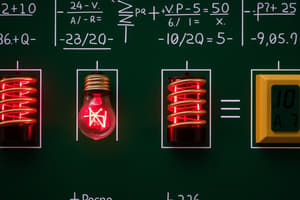Podcast
Questions and Answers
What is the average power consumed by each component per cycle?
What is the average power consumed by each component per cycle?
The average power consumed by a resistor is $I_{rms}^2 R$, by a capacitor is $I_{rms}^2 X_c$, and by an inductor is $I_{rms}^2 X_l$.
Express |z| and θ in terms of x and y for the Argand Diagrams.
Express |z| and θ in terms of x and y for the Argand Diagrams.
For a complex number $z = x + yi$, the magnitude |z| is given by $|z| = \/sqrt{x^2 + y^2}$, and the phase angle θ is given by $θ = \/arctan(y/x)$.
What is the complex generalization of resistance in the context of impedance?
What is the complex generalization of resistance in the context of impedance?
In the context of impedance, the complex generalization of resistance is impedance, denoted by Z [Ω].
What is the first order differential equation describing the time evolution of UR(t) in a series sinusoidally forced RC circuit?
What is the first order differential equation describing the time evolution of UR(t) in a series sinusoidally forced RC circuit?
What is the expression for sinusoidal voltages and currents using Euler’s formula?
What is the expression for sinusoidal voltages and currents using Euler’s formula?
What is the relationship between the phase shift and the impedance for an inductor?
What is the relationship between the phase shift and the impedance for an inductor?
In a series sinusoidally forced RC circuit, what is the expression for the potential difference across the resistor, UR(t)?
In a series sinusoidally forced RC circuit, what is the expression for the potential difference across the resistor, UR(t)?
What is the definition of a phasor in the context of electrical circuits?
What is the definition of a phasor in the context of electrical circuits?
What is the relationship between instantaneous phase and the Argand diagram for a complex number z?
What is the relationship between instantaneous phase and the Argand diagram for a complex number z?
How does the complex impedance of a circuit change when resistors, capacitors, and inductors are connected in parallel?
How does the complex impedance of a circuit change when resistors, capacitors, and inductors are connected in parallel?
What is the relationship between the instantaneous phase and the Argand diagram for a complex number $z$?
What is the relationship between the instantaneous phase and the Argand diagram for a complex number $z$?
In a series sinusoidally forced RC circuit, what is the expression for the potential difference across the resistor, $UR(t)$?
In a series sinusoidally forced RC circuit, what is the expression for the potential difference across the resistor, $UR(t)$?
How does the complex impedance of a circuit change when resistors, capacitors, and inductors are connected in parallel?
How does the complex impedance of a circuit change when resistors, capacitors, and inductors are connected in parallel?
Express $|z|$ and $\theta$ in terms of $x$ and $y$ for the Argand Diagrams.
Express $|z|$ and $\theta$ in terms of $x$ and $y$ for the Argand Diagrams.
What is the average power consumed by each component per cycle?
What is the average power consumed by each component per cycle?
Flashcards are hidden until you start studying




